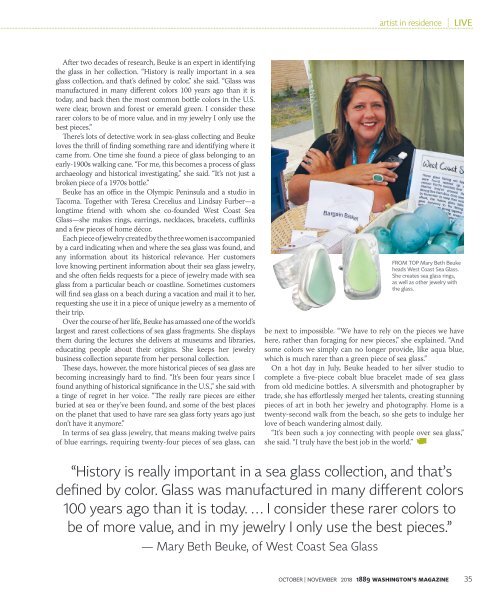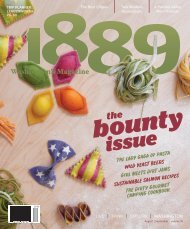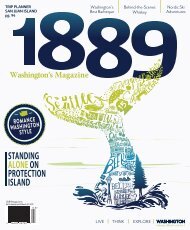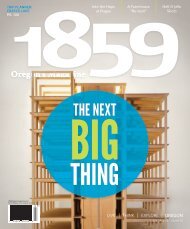You also want an ePaper? Increase the reach of your titles
YUMPU automatically turns print PDFs into web optimized ePapers that Google loves.
artist in residence<br />
After two decades of research, Beuke is an expert in identifying<br />
the glass in her collection. “History is really important in a sea<br />
glass collection, and that’s defined by color,” she said. “Glass was<br />
manufactured in many different colors 100 years ago than it is<br />
today, and back then the most common bottle colors in the U.S.<br />
were clear, brown and forest or emerald green. I consider these<br />
rarer colors to be of more value, and in my jewelry I only use the<br />
best pieces.”<br />
There’s lots of detective work in sea-glass collecting and Beuke<br />
loves the thrill of finding something rare and identifying where it<br />
came from. One time she found a piece of glass belonging to an<br />
early-1900s walking cane. “For me, this becomes a process of glass<br />
archaeology and historical investigating,” she said. “It’s not just a<br />
broken piece of a 1970s bottle.”<br />
Beuke has an office in the Olympic Peninsula and a studio in<br />
Tacoma. Together with Teresa Crecelius and Lindsay Furber—a<br />
longtime friend with whom she co-founded West Coast Sea<br />
Glass—she makes rings, earrings, necklaces, bracelets, cufflinks<br />
and a few pieces of home décor.<br />
Each piece of jewelry created by the three women is accompanied<br />
by a card indicating when and where the sea glass was found, and<br />
any information about its historical relevance. Her customers<br />
love knowing pertinent information about their sea glass jewelry,<br />
and she often fields requests for a piece of jewelry made with sea<br />
glass from a particular beach or coastline. Sometimes customers<br />
will find sea glass on a beach during a vacation and mail it to her,<br />
requesting she use it in a piece of unique jewelry as a memento of<br />
their trip.<br />
Over the course of her life, Beuke has amassed one of the world’s<br />
largest and rarest collections of sea glass fragments. She displays<br />
them during the lectures she delivers at museums and libraries,<br />
educating people about their origins. She keeps her jewelry<br />
business collection separate from her personal collection.<br />
These days, however, the more historical pieces of sea glass are<br />
becoming increasingly hard to find. “It’s been four years since I<br />
found anything of historical significance in the U.S.,” she said with<br />
a tinge of regret in her voice. “The really rare pieces are either<br />
buried at sea or they’ve been found, and some of the best places<br />
on the planet that used to have rare sea glass forty years ago just<br />
don’t have it anymore.”<br />
In terms of sea glass jewelry, that means making twelve pairs<br />
of blue earrings, requiring twenty-four pieces of sea glass, can<br />
FROM TOP Mary Beth Beuke<br />
heads West Coast Sea Glass.<br />
She creates sea glass rings,<br />
as well as other jewelry with<br />
the glass.<br />
be next to impossible. “We have to rely on the pieces we have<br />
here, rather than foraging for new pieces,” she explained. “And<br />
some colors we simply can no longer provide, like aqua blue,<br />
which is much rarer than a green piece of sea glass.”<br />
On a hot day in July, Beuke headed to her silver studio to<br />
complete a five-piece cobalt blue bracelet made of sea glass<br />
from old medicine bottles. A silversmith and photographer by<br />
trade, she has effortlessly merged her talents, creating stunning<br />
pieces of art in both her jewelry and photography. Home is a<br />
twenty-second walk from the beach, so she gets to indulge her<br />
love of beach wandering almost daily.<br />
“It’s been such a joy connecting with people over sea glass,”<br />
she said. “I truly have the best job in the world.”<br />
“History is really important in a sea glass collection, and that’s<br />
defined by color. Glass was manufactured in many different colors<br />
100 years ago than it is today. … I consider these rarer colors to<br />
be of more value, and in my jewelry I only use the best pieces.”<br />
— Mary Beth Beuke, of West Coast Sea Glass<br />
OCTOBER | NOVEMBER <strong>2018</strong> <strong>1889</strong> WASHINGTON’S MAGAZINE 35
















